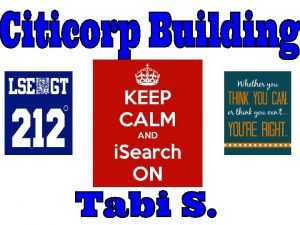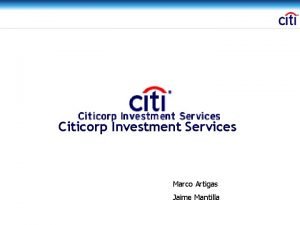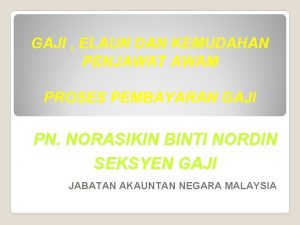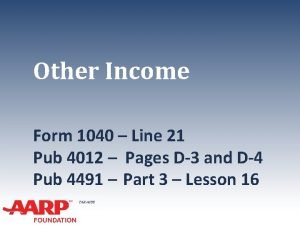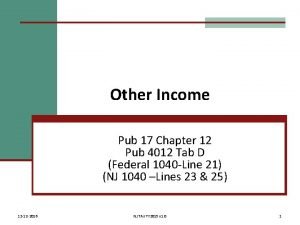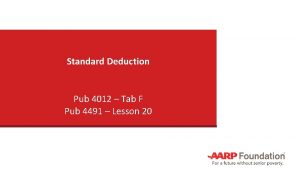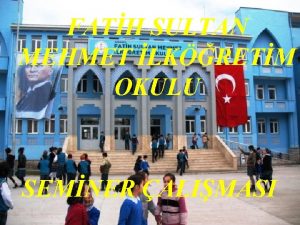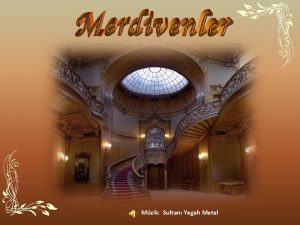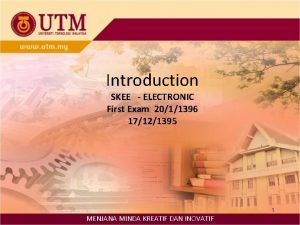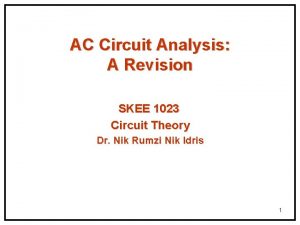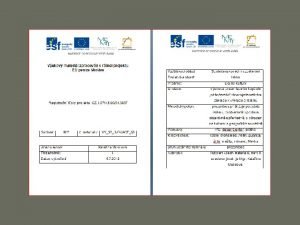Citicorp Center Case SKEE 4012 LECTURER MOHAMED SULTAN



















- Slides: 19

Citicorp Center Case SKEE 4012 LECTURER: MOHAMED SULTAN BIN MOHAMED ALI TEAM MEMBER: YAP YAN ZHI NUR HAFIZA BINTI MOHAMMAD SOM NURUL NAZIKHA BINTI AB RAHIM

Objective To study the case of Citicorp building To learn how the engineer solve the ethical problem

Citicorp’s Plans for a New Skyscraper In Manhattan in the 1960 s, the expanding banking company, Citicorp, outgrew its small office building and needed to buy land to construct a new larger building. The company purchased land from the St. Peter’s Lutheran Church. Part of Citicorps agreement with the purchase was that it was to construct a new church to replace the decaying one AND build their office building without any structural connection to the church. Because of the restriction the church gave, there wasn’t enough room to house the perimeter volume Citicorp needed for a conventional building, so they were forced to go unconventional.

The Impossible Task renowned chief structural engineer William Le. Messurier gets hired for the ambitious project Having founded Le. Messurier Consultants and was the AIA Allied Professions Medal, William Le. Messurier was an accomplished civil engineer. He designed the unique Citicorps building.

Citicorps Unique Design Full Sketches of the building :

Pillar Base Sketches :

Chevron Sketches :

Tuned Mass Damper Sketches :

After Completion The building was completed in 1977 and the problem come out one year later. Diane Hartley, a undergraduate student from Priceton University take Citicorp building as her thesis case study. She found out that the building is weak against quartering winds from her study and calculation. She questioned Le. Messurier’s junior engineers about her findings but they replied that the building is more safer than her calculation. After submitting thesis, her professor also questioned on thesis of Hartley and made a phone call to Le. Messurier.

Column at corners of building Column at center of building

From Le. Messurier’s Investigation, Le. Messurier redo the calculation again by including the effect of quartering winds. From the recalculation, there was a 40% increase in wind loads, resulting in a 160% increase in the load at the chevron brace connection joints. In other words, Citicorp building was not able to withstand against under the strong winds of 70 mph. William Le. Messurier

From Le. Messurier’s Investigation, During construction, a unique design that the chevron wind braces was used to against the wind load. The original design material for chevron load braces used was welded joints. However, the material was changed to bolted joints instead of welded joints during construction by Bethlehem Steel. This substitution is approved by Le. Messurier’s firm but without the known to himself. With the bolted joint chevron braces, the bolts have low resistant to strong wind and the bolts could shear hence the building will collapse.

From Le. Messurier’s Investigation, This building has a tuned mass damper on top of the building, which used to reduce some of the wind loads. But the damper is electrically activated, it will not function if the building suddenly blackout or out of electrical supply. This will make things worse to the building during bad weather, like hurricane. Found that his firm used New York City's truss safety factor of 1: 1 instead of the column safety factor of 1: 2 during calculation. These factors and design combined will put the building in critical danger.

Le. Messurier’s Decision This building has a tuned mass damper on top of the building, which used to reduce some of the wind loads. Le. Messurier has 3 options after he figured out the problem: § Stay silent § Commit suicide § Tell out the problem After taking some serious considerations, he decide to tell Citicorp group about the problem even though he might be get a bad reputation and his career path will be ended. Le. Messurier believed that his selfish worries were not enough to overcome his “social obligation” and his responsibilities as a engineer.

Taking Action Le. Messurier’s following actions and ethical standing

Le. Messurier knew right away that the right thing to do was to take immediate action to repair the building, even though revealing his mistake could cost him lawsuits, bankruptcy and his career. He knew he had the ‘social obligation’, as he put it, to fix his error. Fortunately, the diagonally bracing connections that needed retrofitting were locate between the floors and were relatively accessible He decided to remedy the connections by applying heavy steel-welded band-aids on each side of the joint to build up the strength of the joint

Tuned Mass Damper (TMD) kept the building more stable through repairs and strong winds as long as it was on along the process to repair the building. It is also fortunate since it’s original purpose was to keep the lightweight building from swaying. The repairs took 8 weeks while the TMD was kept on 24/7, the pillars were monitored for any strain and weather forecasters updated with new wind reports 4 times a day.

The Outcome In less than a year, the collapse crises was completely evaded. The repairs were a success. Citicorp is now one of the most secure buildings in all of New York City.

Thank You Q&A Session
 Lecturer's name
Lecturer's name Citicorp building
Citicorp building Citicorp investment services
Citicorp investment services Pub 4012
Pub 4012 Maksud perkataan kuiri
Maksud perkataan kuiri Pub 4012
Pub 4012 Pub 4491
Pub 4491 Pub 4012
Pub 4012 Nttc pub 4012
Nttc pub 4012 Cinderella dressed in yellow kissed a fella
Cinderella dressed in yellow kissed a fella Skee utm
Skee utm Best case worst case average case
Best case worst case average case Physician associate lecturer
Physician associate lecturer Spe distinguished lecturer
Spe distinguished lecturer Good afternoon teacher my name is
Good afternoon teacher my name is Photography lecturer
Photography lecturer Lecturer in charge
Lecturer in charge Designation lecturer
Designation lecturer Designation of lecturer
Designation of lecturer Why himalayan rivers are pernnial in nature
Why himalayan rivers are pernnial in nature

